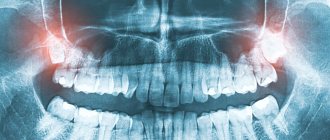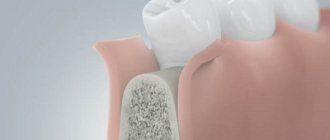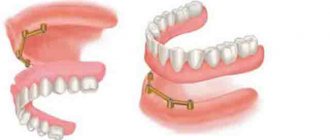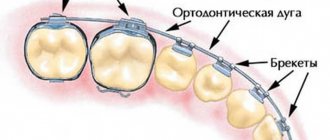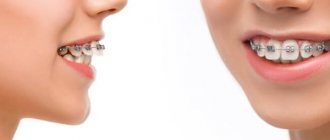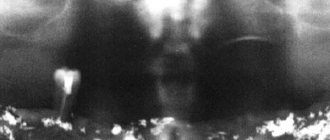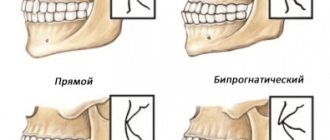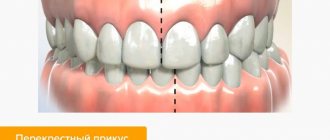9237
For any normal person, the news that he is about to undergo a surgical procedure does not evoke the most pleasant emotions. Many regard this almost as a death sentence.
The dental field is no exception. Any orthopedic procedure plunges the patient into unreasonable shock. In reality, not everything is dangerous, as the patient sometimes seems.
This article will answer questions about how justified surgical intervention is in orthodontic practice, whether there is an alternative, and what complications may arise after surgery.
Advantages
The main advantages of the operation as a method of correcting malocclusions:
- Improving the quality of life, confidence in one’s own attractiveness .
After this method of correction, the patient’s self-esteem increases, psychological complexes associated with personal failure and low self-esteem from a not very presentable appearance, in particular the oral cavity, are eliminated. - The time period of therapy is several times shorter than treatment with the same results, which involves partial amputation of organs.
- Formation of the correct lip position, restoration of the correct profile shape.
- With rare exceptions, this procedure involves complete preservation of healthy organs.
- Ease of maintaining the effectiveness of the treatment.
When surgically moving a jaw fragment to a given position, the organs do not try to repeat the trajectory of the jaw. On the contrary, they maintain their original position. In addition, the teeth are trying their best to come back. This effect is achieved only by wearing mouth guards for a long time. - Minimum retention period.
What is tooth enamel hypoplasia and what method can be used to eliminate the pathology?
Let's talk here about methods for correcting an open bite.
At this address https://orto-info.ru/sistemyi-vyiravnivaniya-zubov/breketyi/po-tipu-materiala/keramicheskie/clarity.html you will find a detailed description of the design of Clarity braces.
When is a bite corrected surgically?
Correcting the bite surgically allows you to eliminate any defects in the structure of the maxillofacial apparatus. The doctor can correct:
- malocclusion;
- discrepancy between the sizes of the upper and lower jaws;
- incorrect position of the jaws relative to each other;
- abnormalities of the jaw joints.
Malocclusion is not just an aesthetic facial defect. An anomaly in the structure of the jaw is a serious deviation that can lead to serious consequences:
- Diseases of the gastrointestinal tract. This is due to the fact that the patient cannot eat properly and chew food.
- Apnea. Due to improper closure and position of the jaws relative to each other, sudden cessation of breathing may occur.
- Dental problems. The abnormal position of the teeth causes uneven distribution of the load in the dentition, as a result of which the enamel is subjected to intense abrasion, the teeth crumble and fall out.
- Violation of diction and articulation. An incorrect bite prevents the patient from communicating normally and leading a full life.
- Headache, toothache and joint pain.
Correcting the bite surgically allows you to eliminate all of these problems, restore self-confidence and improve your general condition.
Indications
The main indications for the operation are:
- pronounced jaw disproportions of an anatomical nature in combination with pathologies of the structure of the dentition;
- a significant violation of the relationship of the jaw fragments relative to each other, excessive development, or, on the contrary, physical underdevelopment of one of them, the inability to fully close the organs or lips (popularly this phenomenon is called the “bird face”). It is distinguished by a large lower jaw;
- a consequence of incorrectly performed surgical treatment of congenital facial abnormalities.
Still have questions? Contact us:
— Does a gummy smile indicate an incorrect bite or not necessarily?
A gummy smile in itself is not a sign of the development of a dental anomaly, and its minor presence may be a variant of the norm and not require any correction. But at the same time, if a pronounced gummy smile is observed, this may indicate excessive vertical development of the upper jaw and as part of dental pathology. In this case, it is worth considering the option of proper treatment (orthodontic and surgical) taking into account all functional and aesthetic aspects with the correction of a gummy smile.
— What if there are no problems with the bite, but the person has a gummy smile?
Most likely this is a variant of the norm. Moreover, such a situation may not fit into the aesthetic canons accepted by society, although anthropometrically everything in a given patient may be conditionally correct.
You ask me: is it worth and is it possible to correct such a gummy smile?
My answer is this. Technically, it is possible to correct a gummy smile. But for this, if the patient has a correct and stable bite, it will be necessary to perform surgery on two jaws: on the upper jaw in order to get rid of a gummy smile, in which case it will move upward and the relationship with the lower one will change, and then on the lower one in order to put it into its original, correct relationship with the top. If the patient’s bite is incorrect, then I would advise approaching the issue properly and receiving complete orthodontic and surgical treatment.
But it’s difficult for me to answer the question of whether it’s worth doing this. Here, each patient himself must make a decision after weighing all the benefits and risks, about which he should receive comprehensive information in consultation with the appropriate specialist.
Here you also need to take into account the fact that the cause of a gummy smile can be a short frenulum of the upper lip, a short upper lip, and increased muscle tone.
In this case, it can be compensated for by surgical intervention on the soft tissues of the lip or with the help of butulin therapy.
— What is the optimal age for orthognathic surgery?
Everything determines the severity of the pathology and its impact on the patient’s quality of life.
It is generally accepted that the most favorable time for orthognathic surgery is the period after completion of skeletal growth (girls after 16 years, boys after 18) and before old age, when the body’s reparative processes decrease. According to statistics, the vast majority of patients are in the age group of 20 to 30 years. It is during this period that a person’s self-awareness is fully formed, they are usually fully aware of their problem (anomaly) and are ready to adequately approach treatment.
But at the same time, we should not forget about complex clinical cases when we are talking about children, about a significant violation of their quality of life and, simply, that there is no way to wait for the end of the body’s growth. Here colleagues from “childhood” come to the rescue and the rules of the game change a little. Pediatric maxillofacial surgeons operate on adolescents, young children, and infants. For which I express my great admiration to them! This is a separate surgical world, with its own rules, laws and complexities.
— Why do they put braces on as a preliminary treatment before surgery?
Dental anomaly is not only a violation of the size and relationship of the jaws, but also an incorrect arrangement of teeth on each of them.
To achieve a good and stable result of the operation, it is necessary to create maximum contacts between the teeth of the upper and lower jaws by correctly positioning them relative to each other, in the dentition. This is precisely the task that an orthodontist sets for himself at the preparatory stage of orthodontic treatment.
— Tell us what is the relationship between an orthodontist and a maxillofacial surgeon?
Bite pathology can be divided into dentoalveolar
and
skeletal
. And if in the first case only orthodontic treatment is sufficient, then in the second, orthognathic surgery is almost always inevitable.
Often, patients turn to an orthodontist for malocclusion without suspecting that he or she has an anomaly in the dental system, which requires an integrated approach to treatment. This is where the interaction between the orthodontist and the surgeon begins. Having assessed the clinical situation, the possibilities of orthodontics and the structural features of the dentoalveolar system, the orthodontist makes a very important decision - whether in this case it is possible to manage only orthodontic treatment or whether it is necessary to resort to combined orthodontic and surgical treatment. After this, the patient is explained the advantages of combined treatment, the features of orthodontic preparation, and he is sent to the surgeon. In turn, I, as a surgeon, also evaluate the clinical picture, the structural features of the dental system and the possibilities of surgery. I clearly explain to the patient all the pros and cons and risks of this type of treatment.
After this, I agree on a treatment plan with the orthodontist and treatment begins.
In general, the role of the orthodontist in the treatment of dental anomalies is simply enormous. Ultimately, the result will depend not only on the surgical stage, but also on the orthodontic stage.
A little about the sad. Unfortunately, there are still orthodontists who have no idea about orthognathic surgery or for some reason deny it. Because of this, patients wear braces for years, which do not give the desired result, and in the meantime, periodontal physiology is disrupted and recessions occur, patients become psycholabile and often at first have a negative attitude towards the combined treatment offered to them, which again includes orthodontic treatment.
— What is the preparation for orthognathic surgery?
After the patient has undergone orthodontic preparation for orthognathic surgery, he goes to the surgeon, who plans the surgical stage.
Planning of orthognastic surgery includes a whole range of manipulations: anthropometric analysis of the patient’s face taking into account proportions and aesthetic parameters, planning of skeletal movements in a special program, analysis of computed tomography data (measurement of proportion and symmetry, localization of nerves, planning of jaw osteotomy lines), dental engineering part ( production of plaster models and their transfer to the articulator to simulate the true relationship of the jaws, “model surgery” taking into account the planned movements and the production of special positioners that will be used during jaw surgery).
Thus, I would like to emphasize that planning an orthognathic operation is a very important stage, in which the course and outcome of the operation depends on the surgeon.
Contraindications
The operation is not indicated for everyone. This method of treating bite pathologies should be abandoned in the following cases:
- age limit is less than 18 years;
- dentally unprepared organ fragments;
- general contraindications – dysfunction of the circulatory system, heart and vascular failure;
- diabetes;
- the presence of infections and inflammatory diseases of the oral cavity until their complete elimination;
- oncological diagnoses.
Contraindications for carrying out
In some cases, the operation is impossible, despite the presence of disturbances in the patient’s bite. Surgical intervention is prescribed by a doctor after a complete diagnosis. Contraindications:
- Presence of diseases of the cardiovascular system.
- Poor blood clotting.
- Age limit. It is important to take into account that performing the operation on persons under 18 is not advisable. The patient's bones will grow, leading to a worse outcome.
Varieties
Orthognathic surgery itself is aimed at solving a specific problem, and there are several treatment options.
Which one will be a priority is decided by the doctor based on the clinical picture of the disease.
Maxillary osteotomy
During the manipulation, the surgeon makes incisions in the bony intraoral tissues located in the area of the eye sockets and the upper part of the dentition.
This step allows the doctor to freely move the upper jaw with tooth fragments and the palatal area. The jaw is set in a given position and secured using a special mouthguard.
Mandibular osteotomy
A significant difference from the procedure described above is that the doctor makes an incision in the bone tissue in a place located behind the root organs. Thus, its integral movement becomes possible.
The fragment is given the desired position, secured with durable titanium alloy plates and left in this state until new hard tissue grows.
Signs of mesial occlusion and treatment offered by modern clinics.
In this publication we will discuss the principle of operation of the Derichsweiler apparatus.
Follow the link https://orto-info.ru/sistemyi-vyiravnivaniya-zubov/breketyi/po-raspolozheniyu/lingvalnyie/inkognito.html if you are interested in the design of Incognito lingual braces.
Genioplasty
It is considered a cosmetic procedure that corrects plastic surgery. Its task is to qualitatively reduce or increase the size of the chin, as well as slightly correct its shape.
The duration of the procedure is determined by the degree of development of the anomaly. When changing an organ, the surgeon uses special prosthetic structures, which he inserts into an internal hole prepared in advance.
To prevent a scar from appearing after this, manual distribution of soft subcutaneous tissue fragments is carried out.
Orthognathic surgery
The surgical intervention is carried out on the basis of a pre-prepared 3D template. During a 4-6 hour operation, a team of surgeons performs an osteotomy of the lower and upper jaw, moving them and fixing them with plates and screws. If necessary, the upper dentition can be expanded due to fragmentation, or genioplasty can be performed - correction of deformities in the chin area.
At NKclinic, the patient receives detailed consultation and planning of the operation, and the manipulations themselves are carried out by our own specialists, but on the basis of hospitals of leading medical institutions with a fully equipped surgical team and the necessary equipment.
Complex, multi-hour facial surgeries are performed only in a hospital setting under general anesthesia.
For surgery, maxillofacial surgeons at NKclinic choose intraoral access, which avoids scars. Thanks to careful planning and the exquisite work of NKclinic surgeons, a 99% coincidence of the predicted result with the actual result is achieved!
Preparation
Before surgical intervention, a set of general preparatory measures is indicated:
- Bringing the oral cavity back to normal – eliminating plaque and calculus, eliminating caries manifestations. Amputation of the root part of organs and removal of decayed teeth.
- Leveling manipulations are a long period and involve the use of braces. After the course of treatment, the specialist, based on the results obtained, plans to correct the bite through surgery.
- Computer preparation - using modern programs, they plan a treatment regimen aimed at correcting the defect and calculate the expected result.
This is possible using 3D technologies that project a panoramic image. Based on the results of such forecasting, a template layout of the future face is drawn up.
Before the procedure itself, you must adhere to certain requirements:
- 7-8 hours before the expected start of the manipulation, do not eat or drink water;
- give up alcohol and smoking one day before;
- If you have any viral or inflammatory diseases or general malaise, immediately inform your doctor and reschedule the procedure.
How is the operation performed?
First of all, a thorough examination of the patient is carried out. A three-dimensional computer model of the jaw is created. 3D modeling allows you to demonstrate to the patient the planned result of the operation and plan the course of the operation. The next stage is the correction of the dentition using a permanent brace system. This usually takes no more than 1.5 years. Only after orthodontic treatment can you begin orthognathic surgery. All manipulations are carried out using general anesthesia. Depending on the complexity, the operation can last several hours. The rehabilitation period usually lasts no more than two weeks. Within a few days after the operation, the patient goes home.
What to take with you to the hospital
The clinic will definitely need:
- passport, referral for surgery and outpatient card;
- personal clothing and footwear;
- Personal hygiene products, optional, towel and bed linen;
- a special sippy cup with a spout, since during the rehabilitation period, especially in the first days, the process of drinking in traditional ways will cause physical difficulties and pain.
You will learn what orthognathic surgery means from the video.
Treatment by an osteopath
Osteopathic correction was performed by osteopathic doctor T.Z. An. Osteopathic support reduces the pain that occurs in muscles and joints associated with bite correction and makes it easier to adapt to changes.
At the secondary appointment (after the operation), osteopath T.Z. An. She also diagnosed intraosseous tension in the jaw. She performed the correction using the Landouzi protocol, focusing on the intraosseous lesion. After osteopathic treatment, the patient noted a decrease in tension in the temporomandibular joints.
Possible complications
If the operation is performed correctly, complications are the exception rather than the rule. But, nevertheless, they sometimes happen. The most common:
- Rupture of the nerve of the lower jaw - occurs during osteotomy. Since the nerve is completely exposed during the operation, there is a risk of damage or complete rupture. Externally, the defect does not appear in any way.
- Damage to the infraorbital nerve affects the inhibition reflexes of nerve impulses. It provokes expansion of the infraorbital canal, which is normally somewhat narrowed. It goes away gradually and spontaneously.
- Damage to the facial nerve is fraught with fragmented numbness of the labial region. Doesn't affect facial expressions.
- Blood loss during manipulation depends on the individual characteristics of the body, and the quality of functioning of the circulatory system, in particular, blood clotting. The complication does not pose a serious threat to the patient’s health.
- Scar formation depends on the sensitivity and structural content of the skin. It can be eliminated with special creams with a wound-healing effect. Not dangerous.
- Damage to teeth occurs due to poor quality of manipulation and lack of professionalism of the doctor. The only solution in this situation is artificial restoration of organs.
- Unexpected bone osteotomy - another operation will most likely be required to eliminate the pathology. The complication arises due to the anatomical features of the patient’s jaw structure and the mobility of bone tissue.
- Deformation and asymmetry are a temporary phenomenon; as the source of inflammation heals, it goes away spontaneously; in severe cases, it is corrected surgically.
- Inflammation - occurs when the oral cavity becomes unintentionally infected.
- A jaw fracture is the result of extreme unprofessionalism of the surgeon. Requires urgent surgical correction.
Upper jaw surgery
In most cases, the indication for maxillary osteotomy is congenital defects. The operation involves more complex manipulations and increased risks. Osteotomy of the upper jaw is performed only by experienced dental surgeons.
Experts recommend deciding on an osteotomy of the upper jaw if the patient is diagnosed with an open or malocclusion, in which there is a pronounced defect in the upper jaw bone (for example, protrusion above the lower jaw or increased jaw size).
Surgical intervention also begins with incisions and opening of the bone, but in the area of the transitional fold. The operation is performed under endotracheal anesthesia. Bone fixation is performed using titanium plates.
Osteotomy of the upper jaw lasts up to three hours. Rehabilitation takes up to 1.5 months, but this is only the main period. Full recovery may take up to 4 months.
